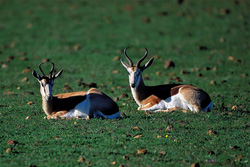The Springbok: An Overview of Its Lifestyle and Environment
The Springbok (Antidorcas marsupialis) is a graceful and agile species of small antelope native to the open savanahs and pine forests of Africa. With its distinctive black-and-white-striped coat and striking, upward-curving horns, the Springbok is easily recognizable. These animals are renowned for their acrobatic leaps, which are not only a spectacular natural display but also an effective means of escaping predators. The Springbok plays a critical role in the ecosystem, contributing to plant dispersal and serving as prey for various predators such as lions and cheetahs. Their adaptability to diverse climate zones and their ability to survive in drought-prone regions make them a fascinating subject in wildlife research. Protecting the Springbok is essential for maintaining biodiversity and the stability of the African savannahs, as they contribute to the health of vegetation and support food chains. Through targeted conservation efforts and protection programs, efforts are made to secure the populations of these elegant animals in the long term and to safeguard their natural habitats against challenges like habitat loss and poaching. The allure of the Springbok lies not only in its physical appearance but also in its behavior and adaptability, making it a symbol of resilience and the beauty of African wildlife.

